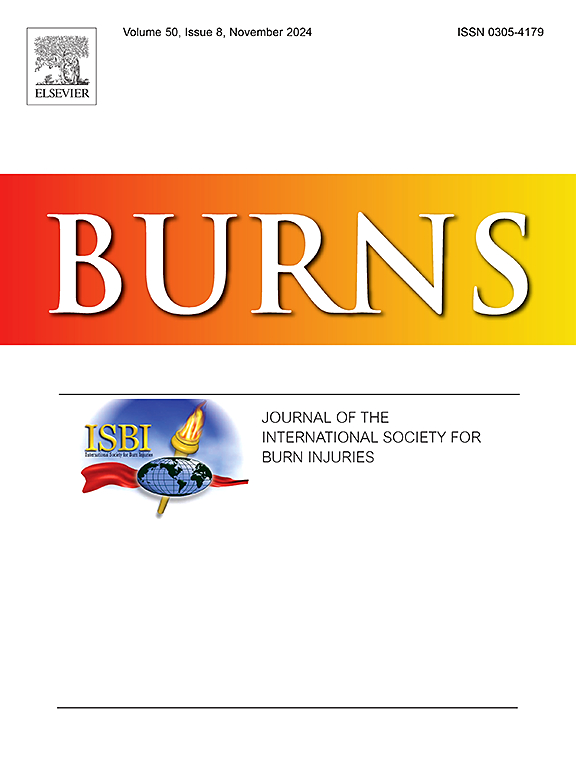采用海藻酸盐/羧甲基纤维素纳米凝胶加速烧伤创面愈合。
IF 2.9
3区 医学
Q2 CRITICAL CARE MEDICINE
引用次数: 0
摘要
使用基于水凝胶的药物输送系统可以帮助实现皮肤损伤后的功能完整性。本研究主要研究海藻酸盐/羧甲基纤维素/氧化锌纳米颗粒/柞蚕水凝胶的制备,并评价其对烧伤创面的再生效果。氧化锌纳米颗粒(ZnONPs)作为抗菌剂,而法法拉(T. farfara)促进伤口愈合过程。治疗14天后,对水凝胶治疗组的特征、体内研究和组织病理学评价进行评估。在体外和大鼠模型中对水凝胶进行了充分的表征和生物相容性和伤口愈合效果的测试。结果表明,该材料具有多孔结构,具有良好的溶胀降解率,良好的血液相容性和凝血指数,以及良好的血液吸收能力。采用MTT法确定生物相容性。含有T. farfara/ znonps的水凝胶对金黄色葡萄球菌和铜绿假单胞菌具有抗菌活性。组织病理学结果显示,与其他研究组相比,再上皮化和组织再生更完全。初步结果表明,海藻酸盐/羧甲基纤维素/ZnO/T。Farfara水凝胶可能是治疗烧伤伤口的好方法,但需要更多的研究来证实这一点。本文章由计算机程序翻译,如有差异,请以英文原文为准。
Accelerating burn wound healing using alginate/carboxymethyl cellulose nanogel containing Tussilago farfara and ZnO nanoparticle
The use of hydrogel-based drug delivery systems can help achieve the functional integrity of the skin after injury. This study focuses on preparing alginate/carboxymethylcellulose/zinc oxide nanoparticles/Tussilago farfara hydrogel and evaluates its regenerative effects on burn wounds. Zinc oxide nanoparticles (ZnONPs) act as an antibacterial agent, while Tussilago farfara (T. farfara) facilitates the wound healing processes. Characteristics of hydrogel treatment groups, in vivo studies, and histopathological evaluation were assessed 14 days after treatment. The hydrogels were fully characterized and tested in vitro and in a rat model for biocompatibility and wound-healing efficacy. The results showed a porous structure, favorable swelling and degradation rates, optimal blood compatibility and blood clotting index, and blood absorption capacity. Biocompatibility was confirmed by MTT assay. T. farfara/ZnONPs-containing hydrogels showed antibacterial activity against Staphylococcus aureus and Pseudomonas aeruginosa. The histopathological results showed more complete re-epithelialization and tissue regeneration compared to the other investigated groups. The initial outcomes suggest that the alginate/carboxymethylcellulose/ZnO/T. farfara hydrogel could be a good way to treat burn wounds, but more research is needed to confirm this.
求助全文
通过发布文献求助,成功后即可免费获取论文全文。
去求助
来源期刊

Burns
医学-皮肤病学
CiteScore
4.50
自引率
18.50%
发文量
304
审稿时长
72 days
期刊介绍:
Burns aims to foster the exchange of information among all engaged in preventing and treating the effects of burns. The journal focuses on clinical, scientific and social aspects of these injuries and covers the prevention of the injury, the epidemiology of such injuries and all aspects of treatment including development of new techniques and technologies and verification of existing ones. Regular features include clinical and scientific papers, state of the art reviews and descriptions of burn-care in practice.
Topics covered by Burns include: the effects of smoke on man and animals, their tissues and cells; the responses to and treatment of patients and animals with chemical injuries to the skin; the biological and clinical effects of cold injuries; surgical techniques which are, or may be relevant to the treatment of burned patients during the acute or reconstructive phase following injury; well controlled laboratory studies of the effectiveness of anti-microbial agents on infection and new materials on scarring and healing; inflammatory responses to injury, effectiveness of related agents and other compounds used to modify the physiological and cellular responses to the injury; experimental studies of burns and the outcome of burn wound healing; regenerative medicine concerning the skin.
 求助内容:
求助内容: 应助结果提醒方式:
应助结果提醒方式:


